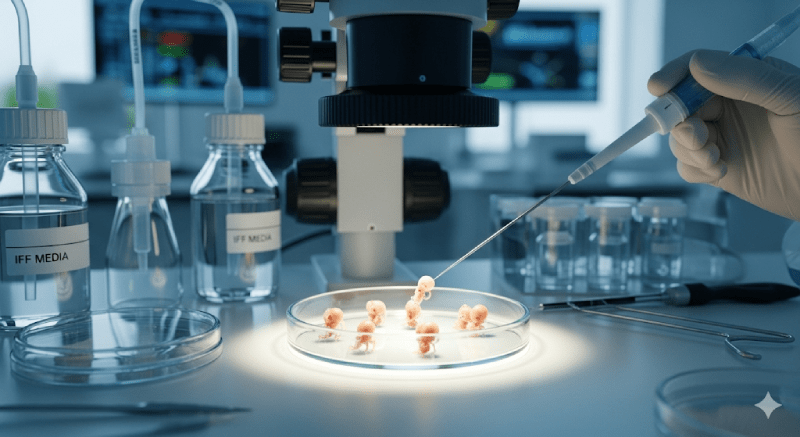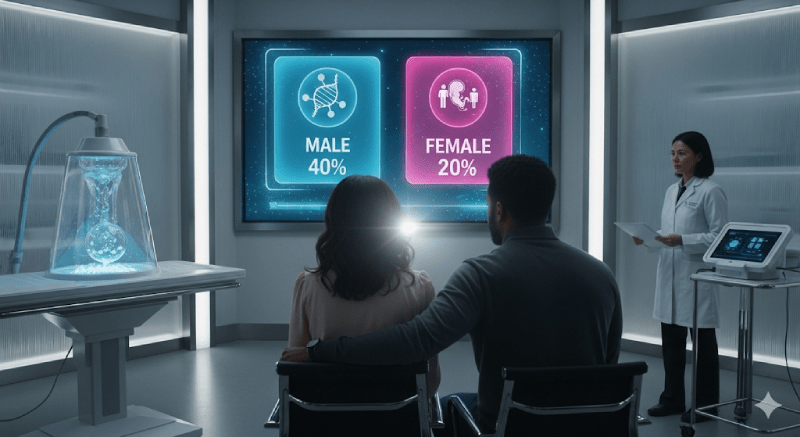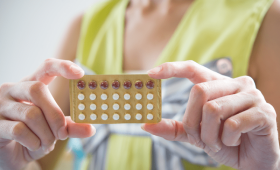What is IVF Gender Selection?
IVF gender selection is the process of determining the gender of an embryo and transferring the desired gender to the mother’s womb, often for purposes like preventing genetic diseases or family balancing. This procedure is performed using a method called Preimplantation Genetic Testing (PGT). With PGT, the chromosomal structure of the embryos is examined, and their gender (XX or XY) is identified. This method also assesses the genetic health of the embryo, increasing the couple’s chance of having a healthy pregnancy.
In Which Cases is Gender Selection Performed?
Gender selection is typically applied in two main situations. The first is to prevent gender-linked hereditary diseases (e.g., hemophilia or Duchenne muscular dystrophy). Since these diseases affect a specific gender, genetic testing and gender selection are performed to have a healthy baby. The second situation is called “family balancing,” where the couple wants to have a child of a different gender than their existing children. Family balancing is practiced in countries with specific legal and ethical regulations.
Are There Legal and Ethical Limitations?
Yes, gender selection with IVF is a subject of legal and ethical debate in many countries. In Turkey, gender selection is legally permissible only for medical necessity, meaning in the presence of gender-linked genetic diseases. Family balancing for gender selection is not legal. In other countries, legal regulations may vary. Therefore, it is important for couples to carefully research the laws and ethical guidelines of the country where they plan to undergo the procedure.
Is the Gender Selection Method Safe?
The PGT method, when applied with IVF treatment, is generally considered safe. The procedure is based on the genetic analysis of a few cells taken from the embryo, and the removal of these cells does not harm the embryo. Research conducted to date has not shown any negative effects of PGT on the baby’s health. However, as with any medical procedure, it is important to discuss potential risks and success rates with your doctor in detail.
What is the Success Rate of Gender Selection?
Gender selection with PGT has an accuracy rate of over 99%. This means that with the transfer of the determined gender embryo, the probability of having a baby of the desired gender is very high. However, the overall success rate of IVF treatment, meaning the rate of achieving pregnancy and live birth, varies depending on factors such as the woman’s age, ovarian reserve, and embryo quality. Therefore, the overall success rate is dependent on these factors.
How is the PGT Procedure Performed?
The PGT procedure begins with a biopsy of the embryo. When embryos reach the blastocyst stage in the laboratory on the 5th or 6th day, a few cells (trophectoderm cells) are taken under a microscope. While these cells are sent to the laboratory for genetic analysis, the embryos are frozen. The analysis results are available within a few days, and a plan is made for the transfer of the genetically healthy embryo of the desired gender.
Is IVF Necessary for Gender Selection?
Yes, gender selection is performed in conjunction with IVF treatment because it requires examining the genetic makeup of the embryo. It is not possible to perform genetic testing on an embryo when pregnancy is achieved through natural means. IVF treatment allows embryos to be created in a laboratory environment and for the necessary cells to be taken for PGT.
What Preparations Should Be Made Before the Procedure?
Before IVF and gender selection treatment, the couple must undergo a comprehensive medical evaluation. Ovarian reserve and hormone levels are checked for the woman, and a sperm analysis is performed for the man. General health checks and genetic counseling are also important in this process. The psychological readiness of the couple for the treatment process is also a significant factor affecting success.
When Should Gender Selection Be Considered?
It is generally considered for family balancing purposes when the couple wants to have a child of a different gender than their existing children. For medical reasons, if there are gender-linked genetic diseases in the couple’s family history, this constitutes a justification for treatment. However, in both cases, it is essential to consult with a genetic counselor and a reproductive health specialist before deciding on the treatment.
Is It Possible to Have Twins or Triplets with This Method?
Yes, in IVF treatment, the chance of twin or triplet pregnancies increases if more than one embryo is transferred. However, since multiple pregnancies carry certain risks for the mother and baby (e.g., premature birth, low birth weight), specialists generally recommend single embryo transfer. This is important to increase both the success rate and safety.
Is the Treatment Process Painful?
The egg retrieval procedure during IVF treatment is performed under light sedation or anesthesia, so it is painless. After the procedure, mild cramps or discomfort may be experienced, but this usually disappears within a few days. Embryo transfer is generally a painless procedure and does not require anesthesia. Patient comfort is a priority to ensure a comfortable treatment process.
How Much Does Gender Selection Add to the Cost?
The PGT procedure added for gender selection increases the total cost of IVF treatment. The cost of PGT varies depending on the number of embryos to be tested and the pricing policy of the genetic laboratory. Obtaining detailed pricing information from the clinic before starting the treatment helps couples with their budget planning.
Is There an Age Limit for Gender Selection?
A woman’s age is one of the most important determinants of IVF treatment and, consequently, gender selection. As age advances, the quality and quantity of eggs decrease, which lowers the chance of achieving pregnancy. For this reason, success rates are lower in women over 40. Some clinics may not offer treatment to women above a certain age.
What Happens in Case of Failure?
If pregnancy is not achieved in the first IVF attempt, the remaining embryos can be frozen and used in a subsequent attempt. If pregnancy does not occur, your doctor will evaluate the reasons for the failure and recommend a different plan for the next treatment. Failure can negatively affect the couple’s psychology, so it is important to seek psychological support.
When Can I Return to My Normal Life After the Procedure?
A few days of rest are recommended after the egg retrieval procedure. After embryo transfer, a few hours of rest are usually sufficient. However, it is recommended to avoid heavy exercise and strenuous activities. Most women can return to their normal daily life within a few days after the treatment.
How Is the Health of Gender-Selected Embryos Evaluated?
The PGT (Preimplantation Genetic Testing) method can detect not only the gender of the embryo but also its chromosomal abnormalities (aneuploidy). This way, the transfer of embryos with chromosomal disorders such as Down syndrome is prevented, and the chance of a healthy pregnancy is increased.
Does This Method Help with Infertility Problems?
IVF gender selection is not a primary method for infertility treatment. However, if the couple has an infertility problem and is undergoing IVF treatment for this reason, gender selection can also be performed at the same time. This is an additional step in the treatment process and does not treat infertility, but it can affect the chance of achieving pregnancy.
How is Gender Selection for Medical Reasons Determined?
Gender selection for medical reasons is determined through genetic counseling and testing. If there is a gender-linked genetic disease (e.g., X-linked diseases) in the couple’s family history, this is documented with a report. This report legally allows for gender selection, and the procedure is performed only for this purpose.
Can Gender Selection Be Performed on Frozen Embryos?
Yes, it is possible to thaw previously frozen embryos and perform genetic analysis and gender determination with PGT. This is an option for couples who want to have children in the future. However, this procedure should be evaluated by a doctor as it may affect the quality of the embryos.
What Are the Side Effects of IVF Treatment?
Side effects of IVF treatment can include ovarian hyperstimulation syndrome (OHSS), mild abdominal pain and bloating, headaches, and emotional fluctuations. These side effects are usually mild and disappear after the treatment. Severe cases of OHSS are rare and can be prevented with regular monitoring.
Can Other Genetic Problems Be Detected During Gender Selection?
Yes, the PGT procedure not only determines gender but can also detect chromosomal and some genetic abnormalities of the embryo. This is done with tests known as PGT-A (aneuploidy screening) and PGT-M (single-gene disease screening). This way, the transfer of genetically healthy embryos is ensured, increasing the pregnancy success rate and reducing the risk of miscarriage.
Is Gender Selection Risky for the Baby?
PGT and gender selection do not pose any risk to the baby’s health. The genetic analysis of the embryo does not negatively affect embryo development. On the contrary, the selection of genetically healthy embryos reduces the risk of birth defects and hereditary diseases. Therefore, the procedure is considered a safe method for both the couple and the baby to be born.
How Old Should I Be Before Treatment?
The ideal age range for IVF treatment is generally the late 20s to early 30s. After the age of 35, the quality and quantity of eggs begin to decrease. This situation not only lowers the chance of achieving pregnancy but also increases the risk of chromosomal abnormalities. However, successful treatments are also possible in the 40s, so a personalized evaluation is important.
Is There a Risk of Ectopic Pregnancy?
Despite the embryo being transferred to the mother’s womb during IVF treatment, there is still a slight risk of ectopic pregnancy. This occurs when the embryo implants in the fallopian tube or another location instead of the uterus. Ectopic pregnancy can manifest with symptoms such as abdominal pain and bleeding and requires emergency medical intervention.

What Can Be Done to Increase the Success Rate of Gender Selection?
Adopting a healthy lifestyle is important to increase the chance of success. A regular and balanced diet, maintaining an ideal weight, avoiding smoking and alcohol, and avoiding stress can help in this process. Additionally, using vitamin and mineral supplements and strictly following the doctor’s recommendations positively affect success.
Is the Quality of Gender-Selected Embryos Evaluated?
Yes, during the PGT procedure for gender selection, the morphological quality of the embryo is also evaluated. Criteria such as the embryo’s cell count, shape, and development rate are examined by embryologists. High-quality embryos, in addition to being genetically healthy, are considered more suitable for transfer.
Can It Be a Solution for Recurrent Pregnancy Losses?
One of the reasons for recurrent pregnancy losses can be genetic abnormalities in the embryos. The transfer of genetically healthy embryos using the PGT method can help prevent these types of pregnancy losses. Therefore, PGT is considered an option for couples with a history of recurrent miscarriages.
Does Gender Selection Require Surgery?
No, surgery is not required for gender selection. The procedure is performed on embryos in a laboratory environment during IVF treatment. Although the egg retrieval procedure is a minor surgical procedure, it is not considered a full surgery.
In Which Cases Cannot the Gender Selection Method Be Applied?
Gender selection cannot be applied in cases where embryos cannot be obtained. This can be due to a very low ovarian reserve in the woman or an insufficient sperm count in the man. Additionally, this procedure cannot be performed in some cases due to legal restrictions.
IVF Gender Selection: Why Travel to Thailand?
Thailand’s first-rate medical services have long been gaining respect on a global scale. The nation is making significant financial investments in its healthcare system. Thailand became one of the world’s nations with the most advanced medical systems as a result of these efforts. Over a million foreigners travel to Thailand every year for medical and surgical operations. Due to the large number of foreign patients who visit Thai medical institutions each year, the medical personnel and service sector employees are highly skilled and experienced at meeting their needs.
Of course, Thailand’s reputation as a top destination for medical tourists is largely due to the low cost of healthcare. Many procedures, including IVF and gender selection, cost between 40 and 70 percent less than those provided in Western nations. Since it may take several IVF cycles to successfully conceive, expenses can quickly add up. For this reason, couples can save a lot of money by receiving IVF treatment in Thailand.
Another factor for having medical treatments in Thailand is the holiday opportunities. Numerous medical tourists fly to the nation every year, but there are also millions of regular tourists that visit its stunning cities like Bangkok, Phuket, Chiang Mai, and Pattaya. You don’t have to spend every waking minute at a clinic if you receive gender selection and IVF treatments in Thailand. There will be plenty of time for you to learn about the fascinating Thai culture, see historical and natural landmarks, savor various foods, and interact with friendly locals. The money saved on medical treatments can be used to pay for all costs.
Finally, the availability of gender selection treatment is the primary factor in choosing Thailand. Only a small number of countries across the world including Thailand, allow for gender selection, therefore many couples travel there because they can’t get the same treatment elsewhere.
Bangkok Fertility Centers
Bangkok, the country’s capital, is home to a large number of public and private hospitals and clinics, making it the medical hub of Thailand. The city is home to some of Southeast Asia’s biggest hospitals, which provide all kinds of procedures, including gender selection and IVF.
Given that it has some of the best medical facilities and a staff of highly qualified medical professionals, Bangkok is a popular location for medical tourism. Numerous reputable medical facilities with good success rates for IVF and gender selection can be found in Bangkok. They pay close attention to the specific needs of each couple and individual, carefully reviewing the patient’s medical history and going over every step of the IVF and gender selection process.
In order to produce the best results and maximize the success rate, they work to optimize every step of the IVF process. Numerous couples have found success at fertility clinics in Bangkok, which are among the most skilled and well-equipped in the region.
Bangkok IVF Gender Selection Costs
Many medical operations and treatments are far less expensive in Thailand than they would be in western countries like Europe, Australia, or the United States. At the moment, IVF treatment packages cost about €6,800 in Thailand’s fertility clinics.
With the price of gender selection treatment included, the overall cost of IVF with gender selection would be around $12,000. Accommodations and transportation between the airport, hotel, and fertility clinic are services offered as part of package arrangements.



